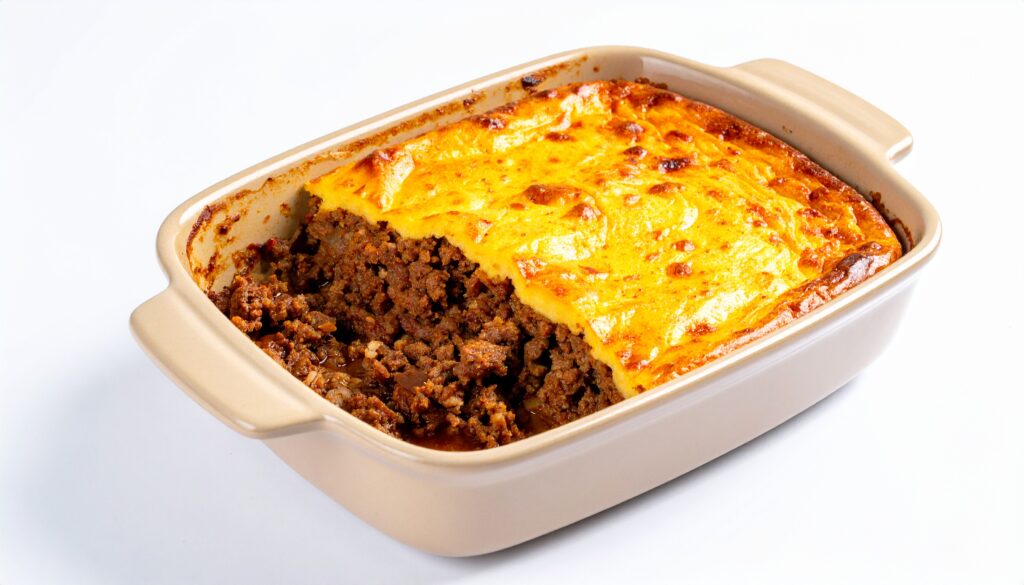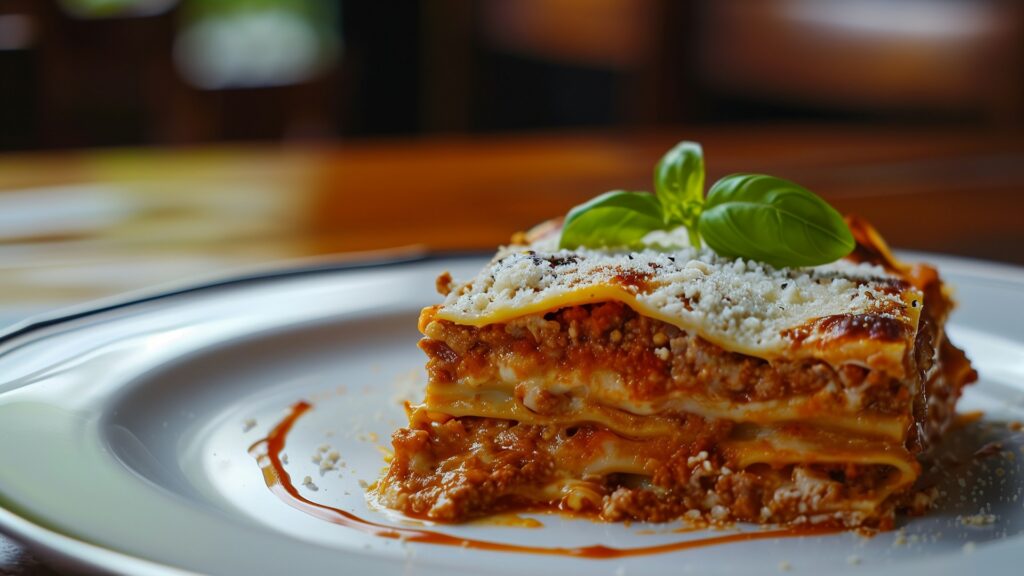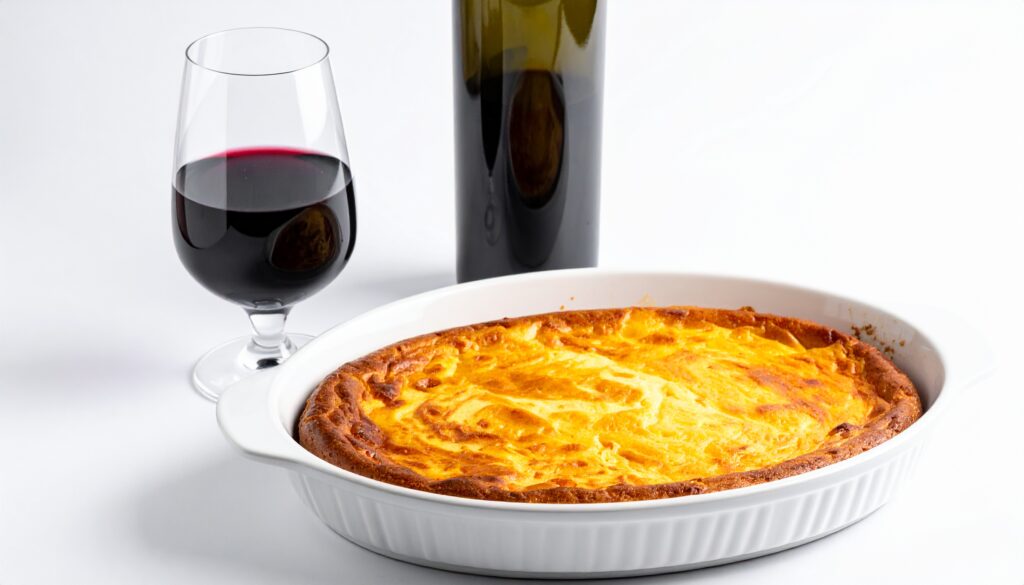Do you know about “Bobotie” from South Africa?
This dish, also known as “South African lasagna,” is a meat dish that offers a unique flavor profile—sweet and spicy.
This time, we've compiled everything you'll want to share with others about Boboti—from its origins to how it's made!
Please enjoy it all the way to the end!
TasteTune introduces diverse cuisines from around the world and also delivers music that expresses those dishes.
Available on various subscription services like YouTube and Spotify, so enjoy it along with this article.
What is Bobotie?

Bobotie is a Cape Malay dish enjoyed throughout South Africa as a home-cooked meal.
Cape Malay cuisine refers to the unique culinary traditions that developed around Cape Town, South Africa.
I'll explain in more detail later, but it was built by slaves and laborers brought from places like Southeast Asia.
Bobotie is made by seasoning sautéed onions and ground beef or lamb with spices, then baking it in the oven with custard.
The spices are curry powder–based, giving it a distinctive flavor, and it is characterized by the soft texture of baked custard.
Additionally, the raisins, sugar, lemon, and other ingredients used can bring out unique sweet and savory flavors, such as sweetness and acidity.
Bobotie is typically eaten with turmeric rice.
It can also be combined with sambal, a spicy condiment.
Sambal is a paste made from chili peppers blended with vegetables and spices.
Using sambal enhances both the flavor and spiciness.
TasteTune「Bobotie」
Hey everyone, have you heard Tastetune's song “Bobotie”?
This music draws inspiration from Bobotie, capturing its homey, heartwarming flavor and the soundscape of a South African sunset.
It expresses a gentle, reassuring rhythm reminiscent of family gatherings and warm African sunsets, so please give it a listen!
Below, we introduce the thoughts, expressions, and creative approaches embodied in this musical work.
The resonance of sound that evokes the scent of spices
At the heart of this piece is the expression through sound of the aromas essential to Boboti—curry, cinnamon, herbs, and more.
Like the scent of spices gently rising, soft layers of sound and_ warm instruments resonate.
Listening to that sound, you can sense the profound charm of Boboti, as if you were inhaling the rich aroma spreading across the dining table.
The warmth and reassurance that envelops the family
A gentle, steady rhythm flows throughout the entire piece.
It's a reassuring rhythm that brings to mind those moments when the family gathers around the table, sharing smiles.
At dusk in South Africa, as the orange sun slowly sinks below the horizon.
I can almost picture the scene of people resting their minds.
Boboti is more than just a dish; it symbolizes family bonds and warmth—music gently conveys this sentiment.
Layers of sound reflecting overlapping flavors
The signature characteristics of Boboti: the tenderness of the minced meat and the smoothness of the egg custard coating it.
These two layers are expressed through overlapping sounds.
The warm sound spreads, and the enveloping melody seems to perfectly mirror Boboiti's mellow flavor.
It's not about flashiness, but rather the inherent gentleness of the ingredients and the exquisite balance with spices—you can feel it through sound.
Savoring the World of Boboti with Your Ears
This piece of music is not just background music.
This is a story told through sound, inviting you to savor with your heart the warmth of Boboti, the aroma of spices, and the happiness of home.
Close your eyes and listen carefully, and the aroma of cooking and your family's smiles should naturally come to mind.
Please surrender yourself to this journey of sound and enjoy the world of Boboti, which expands deep into your heart.
The History of Bobotie

Bobotie is said to have its roots in Indonesia and the Malay Peninsula.
In these regions, cooking methods that generally involved adding spices and sweeteners to meat were commonly used.
This cooking method is common to Bobotie and is considered strong evidence for its origin theory.
The name “Bobotie” is also believed to derive from the Indonesian word ‘bobotok’ (a steamed dish made with coconut) and the Malay word “boemboe” (meaning spices).
And this cooking method was introduced to Africa in the 17th century.
At that time, colonial activities were underway, and it was brought to and spread throughout the Cape Colony (present-day Cape Town, South Africa) by slaves and immigrants brought from Asia.
And the cooking methods they introduced blended with local beef, lamb, milk, eggs, and other ingredients, evolving into South Africa's unique Bobotie.
It is also said that the cooking method of “baking meat dishes with spice flavors topped with custard” was introduced by European immigrants.
The meatloaf and oven-baked dishes they introduced also became part of Bobotie's unique cooking methods.
In other words, Bobotie is the fusion of Southeast Asian spice culture and European oven-cooked cuisine.
Funny Stories from Bobotie
The national dish Mandela loved
Nelson Mandela, the politician who was active primarily in the Republic of South Africa, is said to have enjoyed eating Bobotie throughout his life.
Mandela was a symbol of multicultural coexistence in South Africa, but his favorite dish was Bobotie.
His preference for home-style, down-to-earth cuisine resonated with many citizens, solidifying Bobotie's image as a “dish the nation takes pride in.”
A staple menu item even in school lunches
In South African schools, traditional dishes are sometimes included in the menu.
Among them, Bobotie is one of the most popular menu items.
The reason is that it has a sweet and savory flavor that makes it easy to eat, and because it uses meat and eggs, it provides high nutritional value essential for children.
Like Japanese curry rice, it is cherished as a dish that brings joy when served in school lunches.
Sweet? Spicy? A surprising taste
What makes Bobotie unique is that, despite being a meat dish, it has a distinctly sweet flavor.
The combination of sweet ingredients like chutney and raisins with spices such as curry powder and turmeric creates a complex flavor profile that is anything but monotonous.
Foreign travelers in particular are often surprised by this mysterious flavor that is “sweet yet spicy.”
When eaten with rice locally, the flavors blend together, creating a well-balanced dish.
Why it's called “South African-style lasagna”
Bobotie's appearance, with its browned egg custard on top layered over minced meat, is reminiscent of lasagna or shepherd's pie.
To make it easier to understand, especially for tourists, it has come to be called “South Africa's version of lasagna” by comparing it to a familiar dish.
However, the major difference is that while lasagna uses cheese and white sauce, Bobotie is characterized by its spices and sweetness.

Pairs perfectly with wine
South Africa is also renowned as a premier wine region, and Bobotie pairs exceptionally well with wine.
Spicy Bobotie pairs well with fruity white wines or light-bodied red wines.
Especially the uniquely South African variety “Pinotage” has a subtle sweetness and smokiness that perfectly complements the sweet and savory flavors of Bobotie.
The fact that it's a home-style dish yet pairs well with wine is another aspect that highlights Bobotie's depth.

Bobotie Arrangement
There are various arrangements of Bobotie.
While adhering to the core elements of “sweetness × spice × custard-style egg mixture,” you can freely adjust the balance of meat, spices, and sweetness to enjoy Bobotie tailored to your preferences and the occasion.
This section introduces several representative arrangement examples.
Differences in Meat Types
- Lamb and beef are common choices, but some households also use chicken or pork.
- In today's health-conscious world, lighter variations using turkey or ground chicken are also popular.
Ingredient variations
- Traditionally, raisins and dried fruits are mixed in to add sweetness and aroma.
- On the other hand, there are variations that reduce the sweetness and add nuts and vegetables (such as carrots, spinach, and zucchini).
Range of spices
- Curry powder is the standard, but there are also Indian-style versions that feature a stronger flavor of garam masala, cumin, and coriander.
- The flavor is sometimes adjusted to be milder, making it easier for children to eat.
Differences in Custard
- Traditionally made with milk and eggs, there is also a Malay-style recipe using coconut milk.
- Some households add sugar to give the surface a slightly sweet finish.
Vegetarian & Vegan Bobotie

- This is an adaptation using lentils, chickpeas, and soy meat instead of ground meat.
- The use of coconut milk combined with spices and finished with plant-based ingredients is also gaining popularity.
Combination with side dishes
- Traditionally, it is served with yellow rice (rice cooked with turmeric and raisins), but recently, new styles pairing it with couscous or quinoa have also appeared.
How to Make Bobotie
This time, we'll introduce a classic Bobotie recipe that's easy to make at home.
Ingredients
- Ground beef … 500g (or ground lamb)
- Onion … 1 (finely chopped)
- Garlic … 1 clove (minced)
- Bread … 1 slice (soaked in 100ml of milk)
- Eggs … 2
- Milk … 200ml
- Curry powder … 1 tablespoon
- Turmeric ... 1/2 teaspoon
- Cumin … 1/2 teaspoon (to taste)
- Cilantro … 1/2 teaspoon (to taste)
- Dried grapes (raisins) … 2 tablespoons
- Almond slices … 2 tablespoons (to taste)
- Chutney (or sweet jam) … 2 tablespoons
- Salt ... 1/2 teaspoon
- Pepper … a pinch
- Oil … 1 tablespoon
How to make them
- Heat oil in a frying pan and sauté the onion and garlic.
- Add the ground meat and stir-fry until it changes color, then add the curry powder and spices to release their aroma.
- Lightly squeeze the bread soaked in milk and tear it into small pieces, then add it to the meat.
- Add chutney, raisins, and almonds, then season with salt and pepper.
- Pour into a heatproof dish and smooth the surface.
- Pour the custard mixture made with one egg and 200ml of milk over the top.
- Beat the remaining eggs and brush them over the surface (to achieve a nice golden color).
- Bake in a 180°C oven for 30 to 40 minutes, until the surface is golden brown and firm.
Side dish
- Yellow rice (rice cooked with turmeric and raisins) is traditional.
- Serving pickles or chutney on the side adds a sweet and sour note that enhances the flavor.
Summary
How was it?
This time, we introduced Bobotie, a dish widely enjoyed in South Africa.
The sweet and savory flavor of this meat dish makes quite an impact.
Honestly, I rarely get the chance to eat sweet meat, so Bobotie really piqued my interest.
There don't seem to be many restaurants serving Bobotie these days.
There seems to be a restaurant in Kamata, Tokyo that specializes in Bobotie, so I think you'll be able to enjoy a more authentic taste by going there.
Additionally, it seems Bobotie has been introduced as a South African regional dish at events and other occasions.
If you get the chance, I highly recommend trying this dish.
I'd be thrilled if even one more person who reads this article becomes interested in Bobotie.




Comment